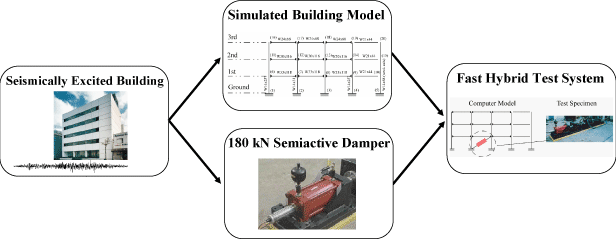Current and Future Fast Hybrid System Projects
Real Time Hybrid Simulation of Two R/C Frames Tested on Shake Tables; Validation and Applications
This international collaborative research capitalizes on two sets of shake table tests (performed in Berkeley and in France), and seeks to assess the feasibility of a more extensive investigation yet at a fraction of the cost through Real Time Hybrid Simulation.
For more information, or to view a video of some exciting results, click here to visit this project's website.
Nonlinear Real-Time Hybrid Test of a Two Story, Two Bay Structure
On March 2, 2005 a Fast Hybrid Test was carried out on the structure illustrated (on the right) in the NEES Laboratory at the University of Colorado. This structure was subjected to approximately 78 percent of the El Centro base motion in the X or shearing direction, as recorded on May 18th 1940 in the Imperial Valley of California.

Click here to view details of this test
Seismic Performance Assessment and Retrofit of Non-ductile RC Frames with Infill Walls
Click for photos and videos from the tests.
KNEX Bridge Competition
Recently the NEES instructional shaketable was used by ASCE to validate the design of a bridge made from a plastic construction kit. Click here for some pictures of this setup.
Internal Site Enhancement, Reaction Wall System and Supplementary Data Acquisition System
Over the next couple of months, the CU FHT system will gain enhanced capabilities through the addition of a reaction wall system and a high-channel count, high-speed SCRAMNet enabled data acquisition system. The reaction wall system will consist of one large fixed reaction member, and two moveable reaction members. More specifications will be publish here as they are finalized.
The supplementary data acquisition system will consist of a flexible National Instruments PXI platform with SCXI signal conditioning. This system will be configured to run real-time operating systems, such as xPC and LabVIEW RT, and non real-time operating systems such as windows and linux. A SCRAMNet interface card will link the data acquisition system controller with our existing high-speed optical control network.
Dynamic Seismic Response of Steel Braced Frames with Innovative Bracing Configurations (Zipper Frames)
This is a collaborative project between several Universities, i.e. Georgia Tech, University of Colorado at Bolder, University of California at Berkeley, Florida A&M University, and University at Buffalo, sponsored by NSF, the division of Civil and Mechanical Systems (CMS) - Award #CMS-0324277 as one of the preliminary NEES-R projects. The project will utilize the George E. Brown, Jr. Network for Earthquake Engineering Simulation (NEES) facilities at UB, UCB, and CU, as well as the large-scale experimental facility at GT to test structural components and systems to provide comprehensive data for the development of analytical models and design recommendations. For more information and to access archived video and data from this project please click here to access the Buffalo NEES site.
Verifying Full-Scale Semiactive Control of Nonlinear Structures
The objective of this research is to investigate and advance the mitigation of structural damage due to natural and man-made hazards through the innovative full-scale experimental verification of semiactive control applied to structures exhibiting nonlinear behavior. The research will utilize the George E. Brown, Jr. Network for Earthquake Engineering Simulation (NEES) shared-use Fast Hybrid Test system at the University of Colorado at Boulder to perform full-scale experimental verification. The experiment will employ hybrid testing of semiactive 180 kN magnetorheological fluid (MR) damper while simulating in real-time the nonlinear response of a building structure subjected to suites of simulated and recorded earthquakes.





